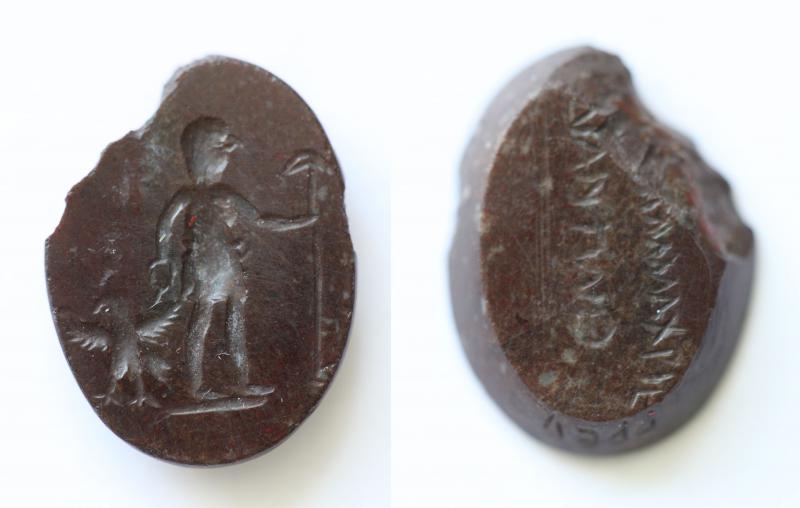Bonner, SMA, 129.
obverse shows the lion-headed monster holding a whip in the right hand, an orb in the left;26 the solar character of the lion, which is elsewhere manifested in his fusion with Horus, is here shown by the whip and orb.27 Scattered the field are the letters of the name Iao. The reverse bears the inscription λεοντορηκτα, which, like γιγαντορηκτα, is sometimes found with Chnoubis, the serpent with the radiate lion's head, again a solar divinity. A stone published by Chiflet resembles that just described, but the lion-headed figure carries a sword — at least so Chiflet or his engraver interpreted it.28 It is not impossible that it is only the staff of a whip, the lash being indistinct. This stone has the reverse inscription γιγαντορηκτα.
This lion-headed anguipede is clearly in a middle position between the common cock-headed god and the numerous representations of a deity in human form except for the leonine head; and among these there is a particularly interesting group of rock crystal gems on which the lion-headed god carries whip and orb. They have been mentioned before, and it will be necessary to return to them later.
Still another variation confines the nonhuman characteristics to the bird head of the deity, who is man in all his other parts. There are some puzzling features connected with stones of this type, the doubts arising chiefly from the difficulty of determining with certainty just what the lapidary was attempting to represent. In some specimens that are known to me a beak makes it clear that the head is that of a bird, but there is no sign of a comb, and consequently no good reason for calling the figure cock-headed. In one instance it is even doubtful whether the stonecutter intended the head for that of a bird or an animal. A Berlin gem (9861) is described by Max Pieper, who published it, as showing “Dämon mit Hahnenkopf und Menschenbeinen, in den Händen Palmzweig und Geldbeutel.”29 But the illustration does not convince one that this description is correct, and there is even a possibility that the badly executed head is meant for that of a dog. The figure would then be a Hermanubis, with whom the palm branch and either a caduceus or a purse are often associated as attributes. The inscription, Iao, cannot be considered decisive, for it is found associated with many other types.
A small olive-brown stone, apparently jasper, in the Newell collection is clearer in the essential detail.30 A figure, entirely human except the head and clothed in a short tunic, stands facing right, the right hand resting on a tall crutch scepter, the pendent left holding an object which may be a garland with hanging ties, or perhaps a variation of the Egyptian sign for protection.31 The beak is prominent, but the top of the head is smooth and round; the
26 Compare PGM I, 143–146.
27 The whip, a reminder that Helios is a charioteer, appears as an attribute of the god on stones that cannot be classed as magical, as B. M. Cat. Gems, 1657 (Pl. 22), 1658; on 1663 the god holds an orb but no whip, although he is driving his chariot.
28 Pl. 8, 34; also in Gorlaeus, Dactyliotheca, II, 364.
29 Mitt. des deutsch. Inst. in Kairo, 5 (1934), 142, Pl. 22.
31 Gardiner, Egyptian Grammar, Sign-list, V 17.
Last modified: 2012-10-29 14:27:25
Link: cbd.mfab.hu/pandecta/1574
